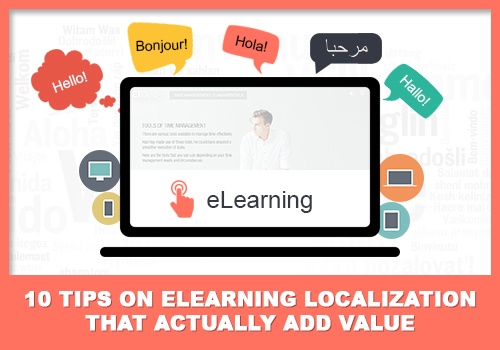What Is eLearning Localization?
Elearning localization is the process of adapting a product to a particular language, culture, and a desired local “look-and-feel”. eLearning localization could be seen as language translation with adaptation for the geographic region in which the product is targeted towards.
Why eLearning Localization?
The primary reason is to reach out to your geographically spread out audience. I think the value of localization in eLearning can be summed up very effectively through this quote by Nelson Mandela:
“If you talk to a man in a language he understands, that goes to his head. If you talk to him in his language, that goes to his heart.”
Easier Said Than Done?
We have been providing eLearning localization services for over a decade now and have localized hundreds of eLearning and mobile learning courses into 26 global languages so far.
What we have noted is that localization should not be an after-thought to your primary development of eLearning. Instead, localization needs processing beyond translation and/or audio integration in another language.
What Works?
Successful eLearning localization projects need to plan for several unique aspects during each of the following phases. I have added tips that will bring in the required value during each phase.
- During estimation.
- During pre-planning.
- During development of the master course.
- During translation and audio recording.
- During integration or development of localized courses.
1. During The Estimation Phase
Tip 1. Identify the required deliverables and scope accurately.
This includes:
- Effort for localization.
This begins with identifying the languages you have to localize into. Remember the effort will vary for languages with special characters. - Scope of localization.
This includes:- User Interface and its elements.
- Content.
- Audio and its transcript.
- Video or only its transcript.
- Character images with or without text/graphs/screenshots.
- Help/Glossary/Resources.
Tip 2. Plan for an accurate estimation using the following for each language.
- Onscreen text word count as well as audio word count (if applicable).
- Mode of delivery: Single SCO per language or multi-language SCO.
- Number of review and testing cycles.
2. During Pre-Planning
Tip 3: Create a design approach that is localization-friendly.
- User Interface.
Should be learner-friendly and intuitive irrespective of the language. - Images and graphics.
It should be possible to replace these easily; avoid having text on images. - Space for text expansion.
Provisioning for adequate space as languages may need extra space for the translated content.
These screenshots illustrate how a localization-friendly design approach can take care of handling these aspects:
3. During Development Of The Master Course
Tip 4. Watch out for cultural nuances.
Validate the selection of colors and other culture-specific aspects as:
- Different cultures have different meanings associated to colors.
- Some gestures may have a different meaning altogether in another culture.
- Certain symbols and icons may convey different meanings in another language.
Tip 5. Plan for a neutralized content.
Avoid references or phrases that may be difficult to translate into another language or may not convey the same value in the translated language.
Tip 6. Identify the components that will not be localized.
For instance, you may choose to localize (or otherwise) currency, units of measurement, the date format, and so on.
4. During Translation And Audio Recording
Tip 7. Always hire professional translators (native speakers) and voice-over artists.
Tip 8. Add a linguistic reviewer to validate the translation.
You can also use them for validation of the localized courses.
Tip 9. Finalize one language.
Once this is completed, ensure the Translation kits reflect the feedback and enhancements and then move on to the balance languages.
5. During Integration Or Development Of Localized Courses
Tip 10. Do extensive testing to simulate how different users will be taking the courses.
It is better to factor for different devices (if mobile learning is part of your solution) or different browsers or different bandwidths. The latter is an important consideration and some countries may have limited bandwidth.
I hope this article is useful and these 10 tips on eLearning localization will actually add value to your localization projects. Please reach out to me if you have any questions or need support in localization projects.
